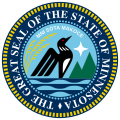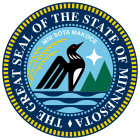| President of the Minnesota Senate | |
|---|---|
 | |
 Incumbent IncumbentBobby Joe Champion since January 3, 2023 | |
| Term length | Two years, no term limit |
| Inaugural holder | Alec G. Olson |
| Formation | January 1973 |
| Website | http://www.senate.leg.state.mn.us/ |
| Politics of Minnesota |
|---|
 |
| Constitution |
Executive
|
| Legislature |
| Judiciary |
| Elections |
| Subdivisions |
Congressional delegation
|
The president of the Minnesota Senate is the presiding officer of the Minnesota Senate. Until 1973, the lieutenant governor served as the Senate president. Since then, presidents have been elected by the body, usually at the nomination of the majority.
While power within the Senate lies primarily with the majority leader, the president of the Senate does succeed to lieutenant governor in the event that office becomes vacant, something which happened most recently in 2018.
1858–1973
From statehood until 1973, the lieutenant governor served as president. Not all lieutenant governors served at the same time as the Senate was in session.
Since 1973
Beginning in 1973, the Minnesota Senate began electing its own presidents.
In accordance with the Minnesota Constitution, Fischbach automatically became Lieutenant Governor of Minnesota on January 3, 2018, after previous Lt. Gov. Tina Smith resigned to accept an appointment to the United States Senate. Fischbach formally resigned from the Minnesota Senate on May 25, 2018. As the Senate did not meet during this time, the position was vacant until Jeremy Miller was formally elected in January 2019.
References
- "Minnesota Senate President and President Pro Tempore, 1849-present - Minnesota Legislative Reference Library". Archived from the original on 2018-07-06. Retrieved 2019-01-08.
- "Minnesota Legislative Reference Library - Senate Presiding Officers". Archived from the original on 2019-01-09. Retrieved 2019-01-08.
- Coolican, J. Patrick. "Fischbach resigns from state Senate, is sworn in as lieutenant governor". Star Tribune. Archived from the original on 2018-12-07. Retrieved 2018-11-29.